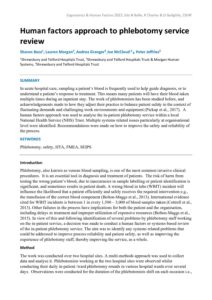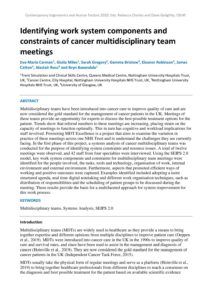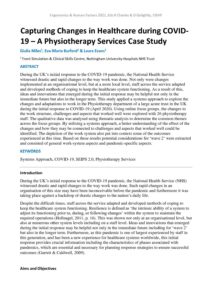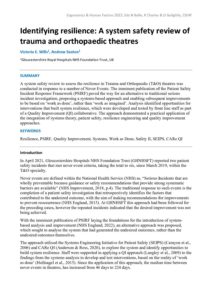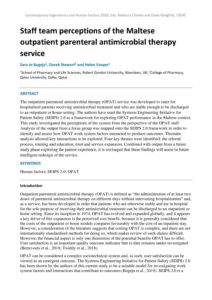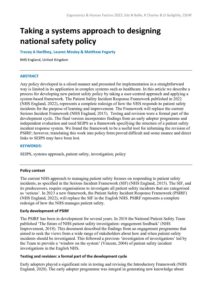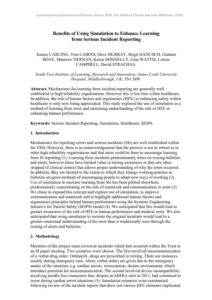SEIPS
Human factors approach to phlebotomy service review
| Document | Author Sharon Beza, Lauren Morgan, Andrea Granger, Joe McCloud 4 & Peter Jeffries |
| Abstract In acute hospital care, sampling a patient’s blood is frequently used to help guide diagnosis, or to understand a patient’s response to treatment. This means many patients will have their blood taken multiple times during an inpatient stay. The work of phlebotomists has been studied before, and acknowledgements made to how they adjust their practice to balance patient safety in the context of fluctuating demands and challenging work environments and equipment (Pickup et al., 2017). A human factors approach was used to analyse the in-patient phlebotomy service within a local National Health Service (NHS) Trust. Multiple systems related issues particularly at organisational level were identified. Recommendations were made on how to improve the safety and reliability of the process. |
Identifying work system components and constraints of cancer multidisciplinary team meetings
| Document | Author Eva-Maria Carman, Giulia Miles, Sarah Gregory, Gemma Bristow, Eleanor Robinson, James Catton, Alastair Ross and Bryn Baxendale |
| Abstract Multidisciplinary teams have been introduced into cancer care to improve quality of care and are now considered the gold standard for the management of cancer patients in the UK. Meetings of these teams provide an opportunity for experts to discuss the best possible treatment options for the patient. Trends show that referral numbers to these meetings are increasing, placing strain on the capacity of meetings to function optimally. This in turn has cognitive and workload implications for staff involved. Promoting MDT Excellence is a project that aims to examine the variation in practice of these meetings across one NHS Trust and to understand the challenges they are currently facing. In the first phase of this project, a systems analysis of cancer multidisciplinary teams was conducted for the purpose of identifying system constraints and resource issues. A total of twelve meetings were observed, and 42 staff from four specialties were interviewed. Using the SEIPS 2.0 model, key work system components and constraints for multidisciplinary team meetings were identified for the people involved, the tasks, tools and technology, organisation of work, internal environment and external environment. Furthermore, aspects that promoted efficient ways of working and positive outcomes were captured. Examples identified included adopting a more structured agenda, real time digital notetaking and different work organisation techniques, such as distribution of responsibilities and the scheduling of patient groups to be discussed during the meeting. These results provide the basis for a multifaceted approach for system improvement for this work process. |
Capturing Changes in Healthcare during COVID-19 – A Physiotherapy Services Case Study
| Document | Author Giulia Miles, Eva-Maria Burford & Laura Evans |
| Abstract During the UK’s initial response to the COVID-19 pandemic, the National Health Service witnessed drastic and rapid changes to the way work was done. Not only were changes implemented at an organisational level, but at a more local level, staff across the service adapted and developed methods of coping to keep the healthcare system functioning. As a result of this, ideas and innovations that emerged during the initial response may be helpful not only in the immediate future but also in the longer term. This study applied a systems approach to explore the changes and adaptations to work in the Physiotherapy department of a large acute trust in the UK during the initial response to COVID-19 (April 2020). Using online focus groups, the changes to the work structure, challenges and aspects that worked well were explored with 26 physiotherapy staff. The qualitative data was analysed using thematic analysis to determine the common themes across the focus groups. By utilising a systems approach, a better understanding of the effect of the changes and how they may be connected to challenges and aspects that worked well could be identified. The depiction of the work system also put into context some of the outcomes experienced at this time. Based on these results potential considerations for ‘wave 2’ were extracted and consisted of general work-system aspects and pandemic-specific aspects. |
Identifying resilience: A system safety review of trauma and orthopaedic theatres
| Document | Author Victoria E. Wills, Andrew Seaton |
| Abstract A system safety review to assess the resilience in Trauma and Orthopaedic (T&O) theatres was conducted in response to a number of Never Events. The imminent publication of the Patient Safety Incident Response Framework (PSIRF) paved the way for an alternative to traditional serious incident investigation, proposing a systems-based approach and enabling subsequent improvements to be based on ‘work as done’, rather than ‘work as imagined’. Analysis identified opportunities for interventions that built system resilience, which were developed and tested by front line staff as part of a Quality Improvement (QI) collaborative. The approach demonstrated a practical application of the integration of systems theory, patient safety, resilience engineering and quality improvement approaches. |
Staff team perceptions of the Maltese outpatient parenteral antimicrobial therapy service
| Document | Author Sara Jo Bugeja, Derek Stewart and Helen Vosper |
| Abstract The outpatient parenteral antimicrobial therapy (OPAT) service was developed to cater for hospitalised patients receiving antimicrobial treatment and who are stable enough to be discharged to an outpatient or home setting. The authors have used the Systems Engineering Initiative for Patient Safety (SEIPS) 2.0 as a framework for exploring OPAT performance in the Maltese context. This study investigated the perceptions of the system from the perspective of the OPAT staff. Analysis of the output from a focus group was mapped onto the SEIPS 2.0 framework in order to identify and assess how OPAT work system factors interacted to produce outcomes. Thematic analysis allowed key interactions to be explored. Four key themes were identified: the referral process, training and education, trust and service expansion. Combined with output from a future study phase exploring the patient experience, it is envisaged that these findings will assist in future intelligent redesign of the service. |
Taking a systems approach to designing national safety policy
| Document | Author Tracey A Herlihey, Lauren Mosley & Matthew Fogarty |
| Abstract Any policy developed in a siloed manner and presented for implementation in a straightforward way is limited in its application in complex systems such as healthcare. In this article we describe a process for developing new patient safety policy by taking a user-centred approach and applying a system-based framework. The Patient Safety Incident Response Framework published in 2022 (NHS England, 2022), represents a complete redesign of how the NHS responds to patient safety incidents for the purpose of learning and improvement. The Framework will replace the current Serious Incident Framework (NHS England, 2015). Testing and revision were a formal part of the development cycle. The final version incorporates findings from an early adopter programme and independent evaluation and used SEIPS as a framework specifying the structure of a patient safety incident response system. We found the framework to be a useful tool for informing the revision of PSIRF; however, translating this work into policy form proved difficult and some nuance and direct links to SEIPS may have been lost. |
Benefits of Using Simulation to Enhance Learning from Serious Incident Reporting
| Document | Author Joanne CARLING, Tom CAIRNS, Dave MURRAY, Birgit HANUSCH, Graham BONE, Maureen TIERNAN, Karen DONNELLY, Gina WATTIS, Louise CAMPBELL, David STRACHAN |
| Abstract Mechanisms for learning from incident reporting are generally well established in high reliability organisations. However this is less true within healthcare. In addition, the role of human factors and ergonomics (HFE) in enhancing safety within healthcare is only now being appreciated. This study explored the use of simulation as a method of learning from error and increasing understanding of the role of HFE in enhancing human performance. |

